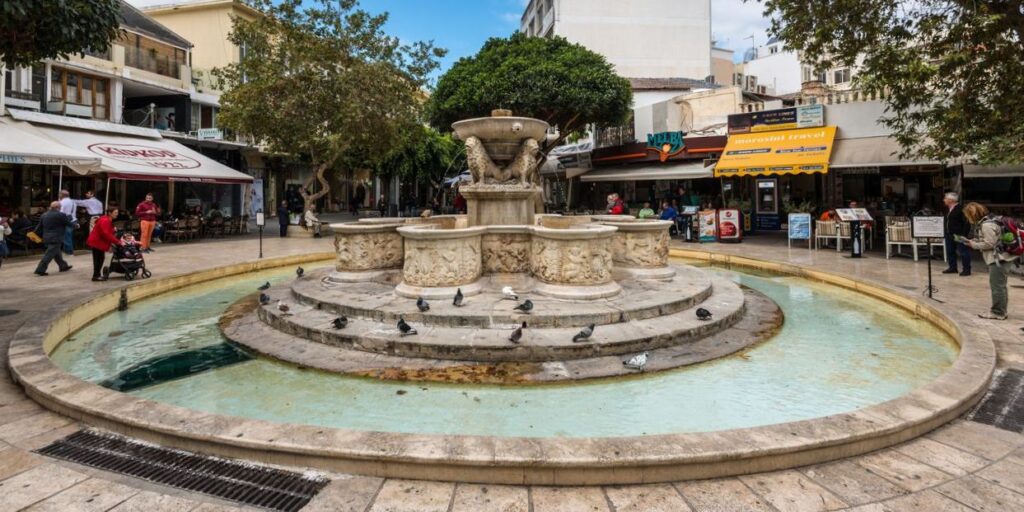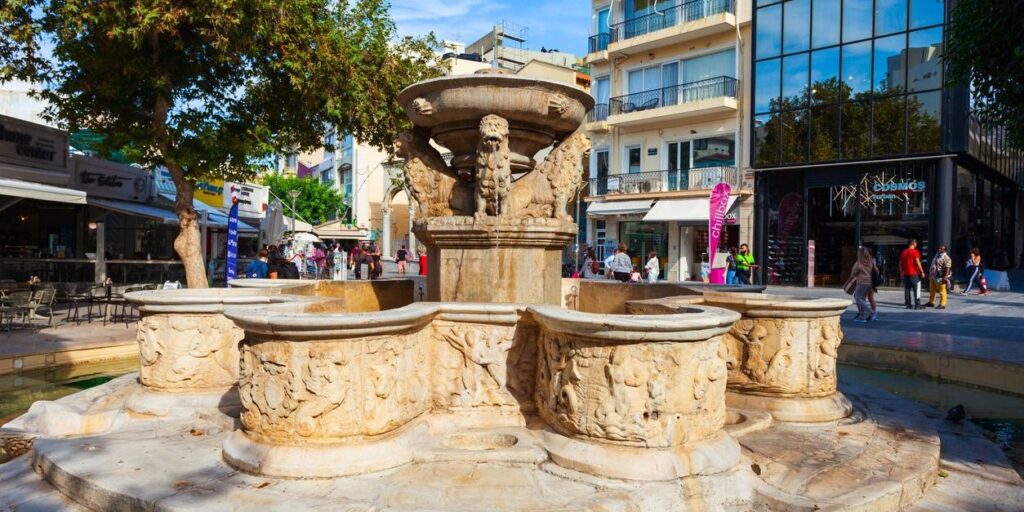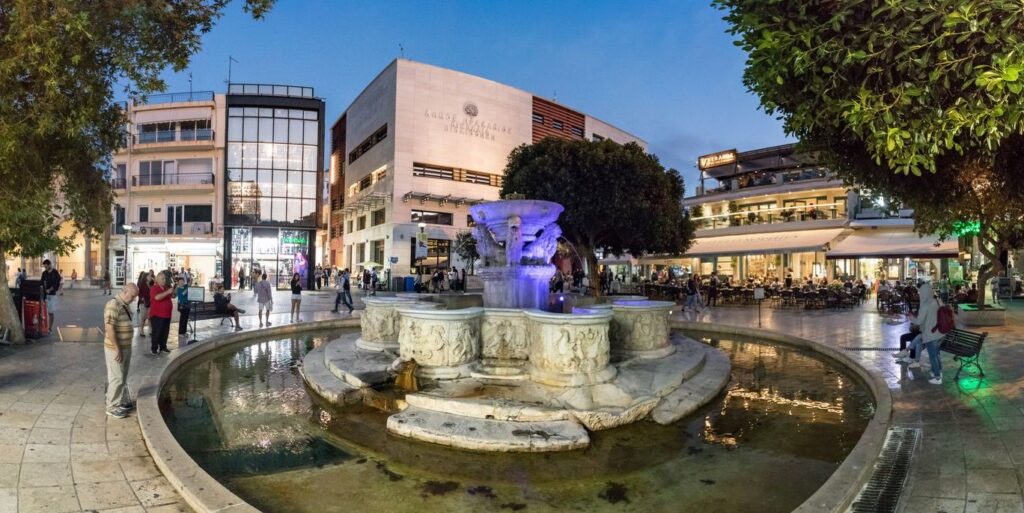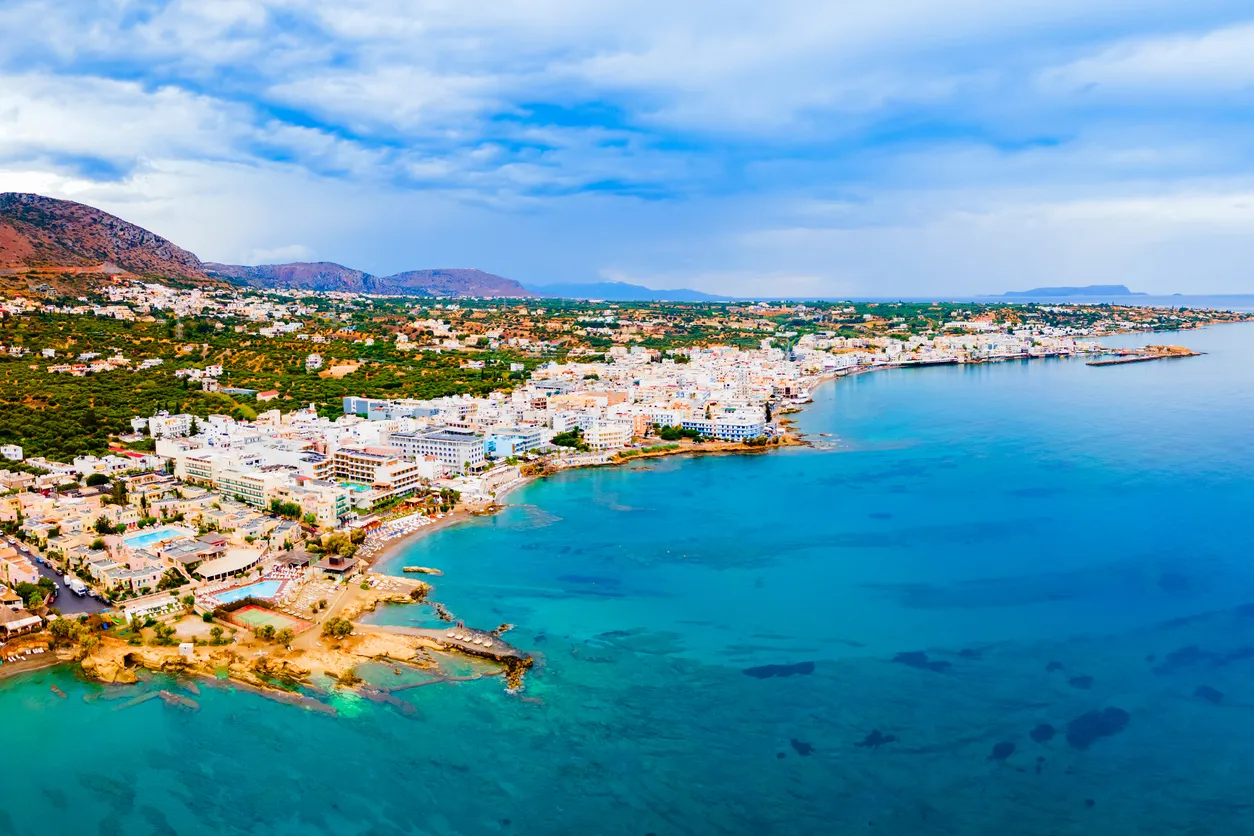Known locally as the “Lions Fountain,” the Morosini Fountain Heraklion is a Venetian masterpiece. It represents the city’s history and is a landmark of Cretan architecture.
In this guide, we’ll explore the Morosini Fountain in Heraklion. Discover its fascinating history, exact location and what to see nearby. We’ll share local dining recommendations and travel tips to help you plan your perfect visit.
The design and origins of the Morosini Fountain Heraklion
The Morosini Fountain Heraklion was built in 1628 under the direction of Francesco Morosini, who was the Venetian governor of Crete at the time. It was built not only as a decorative monument but also as part of the water supply system that brought fresh water from the springs of Archanes from 15 kilometres away, through an aqueduct and a series of underground channels.
The fountain has a circular basin divided into eight lobes, each symbolising one of Crete’s major cities during the Venetian period. Four large lions are at its centre spout, with water pouring from their mouths. This is a traditional symbol of Venice. The basin of the fountain is adorned with reliefs of sea creatures, nymphs, and mythological figures.
Today, it is located in the middle of Eleftheriou Venizelou Square, surrounded by shops, restaurants, and cafés.

How the Morosini Fountain in Heraklion transformed the city’s water supply
The entire aqueduct and fountain system took approximately 14 months to complete and was inaugurated on 25 April 1628, which coincided with the feast day of St Mark, Venice’s patron saint.
At that time, the fountain was essential to the city’s public water supply. It served around 30 people simultaneously and delivered up to 160,000 litres of water per day. Before it was built, the citizens of Heraklion, then known as Candia, continuously suffered from severe water shortages, especially during the summer months.
Changes through the centuries
Since being built, the fountain has gone through restorations and changes.
Venetian era (13th–17th centuries)
- The fountain was a sign of civic pride and an urban centrepiece symbolising the prosperity of Candia under Venetian rule.
Ottoman period (17th–19th centuries)
- The fountain continued to operate, though some decorative elements were altered or removed.
Modern era
- The fountain went through several restorations in the early 20th century to restore its original Venetian appearance. Today, it remains one of the best-preserved monuments in Crete’s capital.
Facts and legends about the Morosini Fountain Heraklion
🌊 It’s said that the fountain originally had a statue of Poseidon on top, later destroyed during an earthquake.
💧Some believe the water of the Morosini Fountain had “healing properties” due to its purity.
⛲The fountain still uses water from the same source in Archanes.

Where is the Lion’s Fountain located in Heraklion?
You’ll find the Morosini Fountain Heraklion right in the centre of the old town, in Lions Square, also called Eleftheriou Venizelou Square. It’s one of the most lively areas in the city, a must-see stop when travelling through Heraklion’s old town.
How to get there
On foot: The fountain is about a 10-minute walk from the Venetian harbour and Koules Fortress.
By public transport: Local buses stop at nearby Liontaria Square or the Archaeological Museum.
By car: Parking can be tricky near the old town, so it’s best to park slightly further out and walk in.
What to see and do near the fountain
The Morosini Fountain is surrounded by many of Heraklion’s main attractions, making it an excellent starting point for sightseeing.
Start your visit at the Venetian Loggia. This 17th-century building once served as a meeting hall for Venetian nobles.
Next, just across the square, step inside St Mark’s Basilica, now home to the Municipal Art Gallery, where you can visit exhibitions and explore local artworks.
Afterwards, make your way down to the harbour to explore Koules Fortress. This impressive Venetian stronghold has beautiful sea views and provides a fascinating look into the island’s maritime defences.
Then, continue your walk about 500 metres inland to the Heraklion Archaeological Museum, where you can learn about priceless Minoan treasures, including artefacts from the Palace of Knossos.
Finally, end your day with a stroll along Old Market Street. This is the perfect spot to pick up local olive oil, herbs, spices, and handmade souvenirs before enjoying a well-earned coffee back at Lions Square.
Tips for visiting the Lion’s Fountain in Heraklion
- Go early or late: Visit in the morning for fewer crowds and great lighting, or in the evening to enjoy the fountain beautifully lit and the lively square atmosphere.
- Time needed: Spend around 15–30 minutes to take photos and appreciate the details.
- Easy access: The area is pedestrian-friendly and suitable for wheelchairs and strollers.
- Avoid peak times: It’s busiest between 10 a.m. and 2 p.m., especially during summer.
- Don’t drink the water: It’s for display only!
💡 Want to explore more?
Check out our itinerary of the other Venetian fountains in Heraklion, including Bembo Fountain, Priuli Fountain, and Sagredo Fountain. Combine them into a short walking route through the city’s old town for a perfect day of sightseeing.
Activities and local flavours near the fountain
The Morosini Fountain Heraklion is an ideal starting point for exploring the old town. We highly recommend joining a guided walking tour to discover the Venetian walls, the old port, and nearby historic sites.
For a break, enjoy a coffee, fresh juice, or a slice of bougatsa, the city’s signature pastry, while watching daily life unfold in Lions Square. In the evening, the area becomes lively with music and the illuminated fountain.

Plan your visit to Heraklion and see the Lion’s Fountain for yourself
The Morosini Fountain in Heraklion is a symbol of the city’s history and everyday life. Make the most of your visit with a simple itinerary:
☕ Morning coffee by the fountain
🏛️ Visit the Archaeological Museum
🍽️ Lunch nearby
🚶 Afternoon stroll through the old town
For a comfortable stay close to Heraklion’s highlights, Oreo Travel has apartments and holiday homes that combine style, comfort, and authentic Cretan hospitality.
Plan your visit today.






